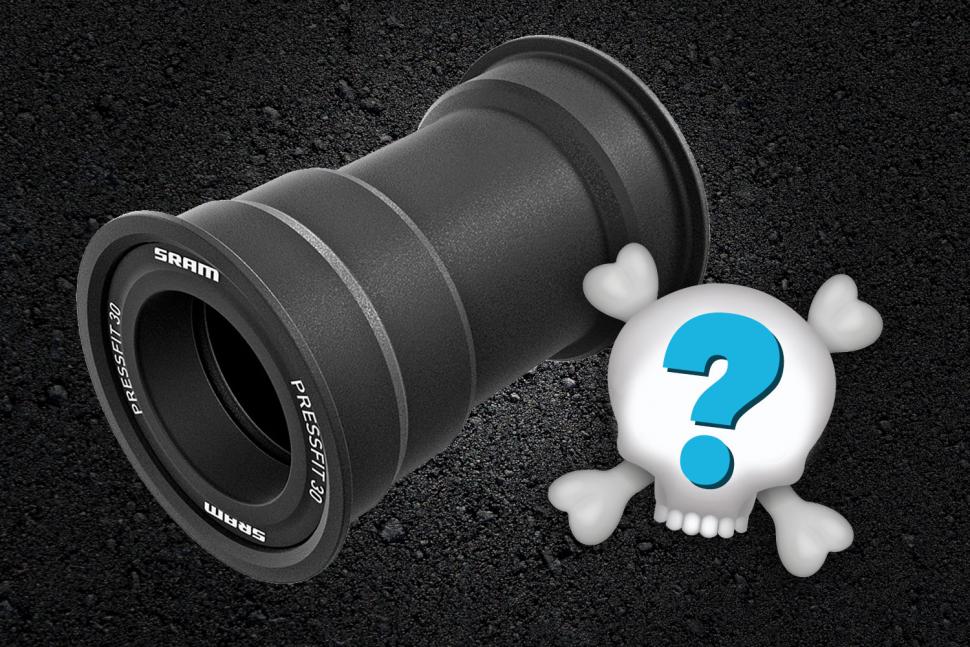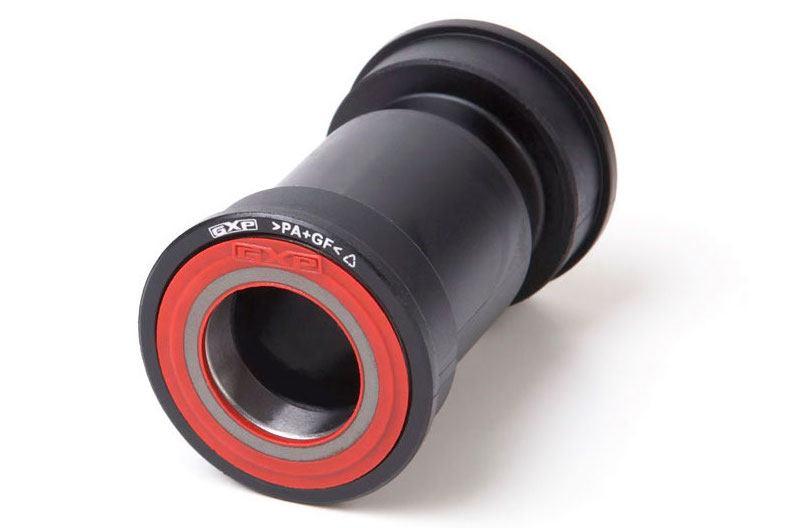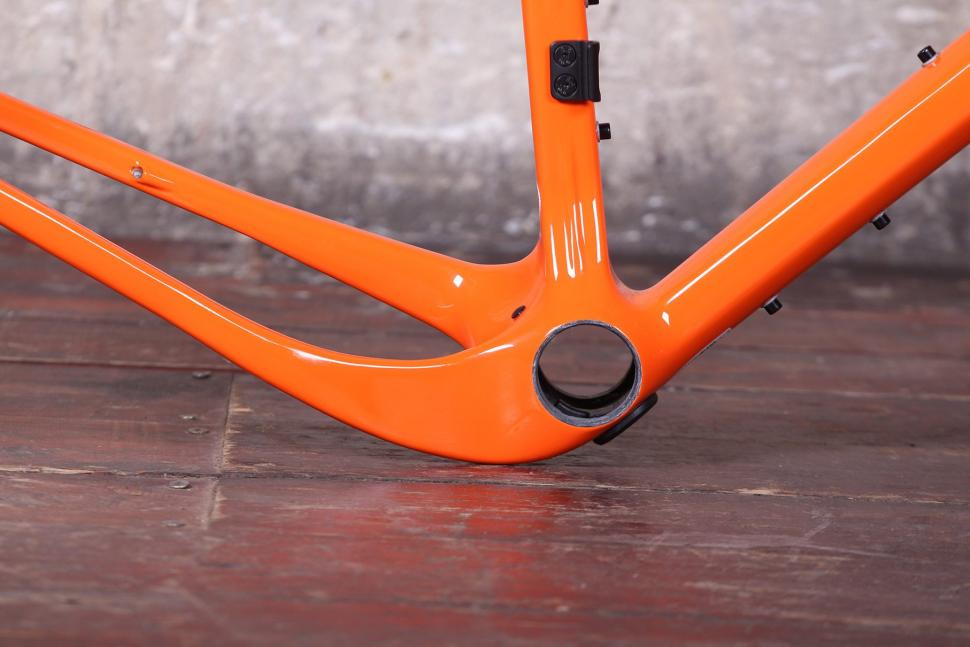- News
- Reviews
- Bikes
- Accessories
- Accessories - misc
- Computer mounts
- Bags
- Bar ends
- Bike bags & cases
- Bottle cages
- Bottles
- Cameras
- Car racks
- Child seats
- Computers
- Glasses
- GPS units
- Helmets
- Lights - front
- Lights - rear
- Lights - sets
- Locks
- Mirrors
- Mudguards
- Racks
- Pumps & CO2 inflators
- Puncture kits
- Reflectives
- Smart watches
- Stands and racks
- Trailers
- Clothing
- Components
- Bar tape & grips
- Bottom brackets
- Brake & gear cables
- Brake & STI levers
- Brake pads & spares
- Brakes
- Cassettes & freewheels
- Chains
- Chainsets & chainrings
- Derailleurs - front
- Derailleurs - rear
- Forks
- Gear levers & shifters
- Groupsets
- Handlebars & extensions
- Headsets
- Hubs
- Inner tubes
- Pedals
- Quick releases & skewers
- Saddles
- Seatposts
- Stems
- Wheels
- Tyres
- Health, fitness and nutrition
- Tools and workshop
- Miscellaneous
- Tubeless valves
- Buyers Guides
- Features
- Forum
- Recommends
- Podcast
 Is pressfit dead Sept 2018
Is pressfit dead Sept 2018Fed up of pressfit bottom brackets? Find out if something better is on the way
There are many ‘standards’ in the road cycling world but none that causes more ire than pressfit.
Cannondale developed the BB30 bottom bracket in 2006 as an open standard. It used a larger 30mm axle which allowed bigger bearings and a bigger bottom bracket shell, providing extra stiffness and lower weight. But it required a precision machined shell and crank, and was expensive to manufacture with an alloy shell bonded to the carbon frame.
Pressfit soon followed in 2009 and aimed to address the high tolerances of BB30 by housing bearings in nylon composite cups that are then pressed directly into the frame. It reduced the manufacturing costs, and this helped it to be swiftly adopted by frame manufacturers. It still offered all the same weight and stiffness benefits of BB30, but with more simplicity and lower cost.
However, while the use of plastic shells lowered the critical need for high tolerances, variations in quality control lead to a litany of creaking bottom brackets, a result of a poor interface between the bearing and frame. Internet forums are full of frustrated cyclists trying to cure noisy pressfit bottom brackets.
- Video How To: Install a PressFit Bottom Bracket
- How to remove press-fit bottom bracket bearings
But something interesting is happening in the industry. We’re seeing new frames being developed with conventional threaded bottom brackets replacing pressfit, to the rejoicing of cyclists everywhere deafened by creaking pressfit installations.
Could it be that the love affair with pressfit is over and the tide has turned back in favour of the threaded bottom bracket? We spoke to two bike brands big (Specialized) and small (Bowman Cycles) to get their perspective the future of pressfit.
We asked these companies because Bowman’s updated Palace R frame has swapped from pressfit to threaded, and for its new Roubaix Specialized has used a threaded bottom bracket on the entry-level model and a pressfit on the top-end S-Works bikes.
Bowman Cycles
I think the primary problem with pressfit is that an error at any stage can cause the most horrendous noise problems, and they are not easy to remedy without spending money. A threaded bottom bracket, on the other hand, can be taken out, greased, retightened and fettled far more readily, and the threading does away with the need for such accuracy during the manufacture, as by nature it will tighten (as long as the frame is faced properly).
The larger pressfit shells do allow for carbon engineers to do interesting things with layup and tube size, but for metal frames, the benefits from a frame manufacturing process are limited, if you can afford to research and develop any chainstay designs tyre clearance preference require.
In metal frames, I’d suggest they should be dead as every manufacturer makes a superb chainset that fits natively. Carbon is another matter as the customer seems to want to chase the smallest number of grammes as the latest must have. Bonding in a thread for a bottom bracket is not only adding a possible failure point down the road, it also adds weight in a world where people are spending a lot of money to save six grammes making a totally hollow dropout.
The customer just needs to realise that the high tolerances needed to make a pressfit bottom bracket work in a carbon frame cost money. It can be done - and people shouldn’t be fobbed off if their high-end composite bike creaks, but they also need to be realistic. There are solutions out there that companies can use to make reliable, light frames, Colnago’s C60 has an elegant solution and a frame that still builds up stupidly light. The T47 standard is another option that privately many product managers want too use, but the gram chasing mainstream does not permit it.
So, is it dead? Yes, kinda, maybe - not quite.
- How to fit a threaded bottom bracket
Specialized
Without it sounding a cliché, Specialized is, and has to be, about rider first engineering; we have to look at the rider at every level and with every budget first to give them the bike and equipment that gives them the best riding experience and performance benefit.
So the easiest answer to this is, yes, for Specialized pressfit bottom brackets still have a future where absolute performance matters, given that they are stiffer and lighter than a conventional threaded bottom bracket.
The ‘but’ is that a pressfit system requires incredibly high tolerances and the highest standards in quality control in frame manufacture for it to function at its absolute best, and this realistically is achieved with high cost and low volume.
The other variable is the frame material and method of manufacture.
So, with the new Roubaix platform as an example, Pro and S-Works models have a press fit BB30 system, and Expert level and below use a conventional threaded bottom bracket.
road.cc comment
We doubt pressfit is going to vanish anytime soon. For high-end frames developed for racing the weight and stiffness benefits trump all other concerns, and some of the issues are often down to poor installation. For professional racers, bikes are regularly cleaned and maintained. For cyclists that don't have a pro mechanic washing their bike after every ride, Park Tool has interestingly developed special compounds that it reckons helps to eliminate the potential for a creaking pressfit bottom bracket. We'll be testing those soon to see if they are the perfect solution.
But it's clear pressfit has lost many fans over the years. There's no denying the simplicity and ease of installation offered by a threaded bottom bracket setup., and the bearings appear to be less susceptible to British weather and infrequent servicing plans. So, we fully expect more bike brands to follow Bowman and Specialized's lead for bikes aimed at regular everyday cyclists rather than the pro racers, who don't have to pay for or look after their bikes, and spec threaded bottom brackets.
What do you think? Will your next bike have a pressfit bottom bracket or has the creaking driven you mad?
David worked on the road.cc tech team from 2012-2020. Previously he was editor of Bikemagic.com and before that staff writer at RCUK. He's a seasoned cyclist of all disciplines, from road to mountain biking, touring to cyclo-cross, he only wishes he had time to ride them all. He's mildly competitive, though he'll never admit it, and is a frequent road racer but is too lazy to do really well. He currently resides in the Cotswolds, and you can now find him over on his own YouTube channel David Arthur - Just Ride Bikes.
Latest Comments
- chrisonabike 1 sec ago
This is an expression of the problem right there. And we'd be embracing a hopeless arms race if more people get the idea. Doubly so if more...
- jaymack 15 min 9 sec ago
"I never paid attention to my financial affairs...". It may sound harsh as I'm sure he was royally taken advantage of but most people don't have...
- hawkinspeter 19 min 20 sec ago
Resorting to fines just sends the message that it's okay to be run over by rich people.
- the little onion 1 hour 3 min ago
Rather artistic photo of this (driverless) car that has ended up on its roof on a dead straight road in Bradford....
- mdavidford 1 hour 29 min ago
If the trees are now a smokescreen, it doesn't sound like there's much to save any more.
- hawkinspeter 1 hour 47 min ago
Cool - that removes one of my issues with Garmin. I'm quite happy with the Wahoo Elemnt Bolt, so I doubt that I'll be switching unless Garmin come...
- slc 2 hours 43 min ago
No doubt it will catch on in Plymouth, but it is Devon, where everything happens 10 years later. Not least the buses....
- mctrials23 3 hours 24 min ago
GCN just did a cool video on this. All I could think by the end was that perhaps if you got to do what the presenter did and mince around Italy in...
- ravenbait 3 hours 33 min ago
I missed that, thanks for pointing it out. I can't comment, as that's outside my area of expertise. Apologies to Rendel. This is why they should be...




Add new comment
82 comments
So I guess I must be one of the rare cases of a breakdown-free Cannondale user. And I've had seven of them so far.
same here. 2013 synapse has never creaked with its bb30. I like bb30 so much, i spec'd it on the custom ti bike, nary a creak there either
welcome, member of noncreaking Cannondale bike rider! My bb30 synapse of 4 years has remained silent. So much so that i had no problem tempting fate by speccing a titanium bike with bb30 a year after that. This one is also a noncreaker.
My Synapse developed a BB30 creak after a wet winter and re-greasing it only helped temporarily, but a little bit of Loctite on the interface between the frame and the bearing shell solved it.
Nope, it was stripped a refitted 3 times, glued in to manufacturers spec and knocked every ride the first 3 miles till it settled and found somewhere to grip. Drove me to distraction.
Yeah, same here. Nothing with PF30 and nothing with OSBB. Maybe it's the quality of the C-Bear bottom brackets I fit into the frames?
68mm threaded in my KTM CF frame (one of the reasons I chose it) and I have no problems at all with a 1000 watt peak power input.
I don't seem to remember the pros having much difficulty knocking out ridiculously high watt numbers on threaded frames on all materials on a very regular basis, nor indeed on track frames so unless you feel you're losing something in efficiency that is critical to your riding then a threaded BB frame shouldn't be an issue at all.
The major problem is the sheer number of press-fit standards (BB86/92, BB90/95, BB386/392EVO, PF30, BBright). Even BB30 itself, and all its variants, is still technically press-fit because you're still pushing bearings into a shell and not spinning them into a threaded one.
My TCX has a BB86 shell. So far so good. Out of the press-fit bottom bracket formats it's the one I've heard the least headaches about; on the other end of the spectrum are BB30 and PF30.
You also have BB30 to thank for introducing the idea of a 30 mm aluminum crank spindle, which introduces all sorts of bearing-related problems on its own. Shimano and Campagnolo, for the most part, haven't seen the need to graduate from their current 24 and 25 mm steel crank spindles.
Well, that would be a fine state of affairs; we've all bought in to the "PRESS-FIT BB and now they want to change thm; well lets hope they design a fitting to go in to a Carbon Bottom Bracket shell; so that the Press-Fit can be turned in to a threaded BB. on a carbon frame.
Of all the bottom bracket standards ive had over the years i much prefer Colnago's solution to the press fit bottom bracket over any others
They have their Threadfit system, basically its two large cups that you thread into your frame which you then press a normal press fit bottom bracket into it
If it develops any creaks (none so far in 5000 miles) you can just replace the BB, grease the cups or even replace the cups
Plus as the cups are large to accommodate the pressfit bb means they can make the downtube/bb interface much larger increasing stiffness
Certainly noticed the difference when going from my C59 with euro bb to my C60 with the threadfit system, the whole BB area is so much stiffer with notciable less flex
http://www.cyclingnews.com/features/colnago-c60-released-blending-tradit...
Pressfit manufacturers should seek to bolster their position by putting it to a vote among the cycling community. And the perfect slogan for them has recently become available: "Vote BB30 for a strong and stable cycling future!"
I think they'd be better off with something like, "Don't get screwed, just push it in!"
Oh please let this be true - I want bikes and frames without a built in creak, so the sooner this press-fit monstrosity of a idea becomes a long forgotton memory the better.
Threaded but only Italian cut
People are saying 'high tolerance' when they actually mean 'low tolerance'.
As applied to bottom bracket standards, the appropriate word I believe is "sloppy" - especially with PF30.
Exactly, all the way through, high when they mean low. Obviously no engineers there.
If it was my choice, I'd happily sacrifice a few grams at the bottom bracket to have a stronger and more reliable system, T47 or something similar to Colnago's solution seem like a good idea if the oversized bearings are desired.
I totally agree with bowman's, if it's a metal frame, a threaded bracket makes much more sense, the increased size for any other standard seems a little pointless unless you've got some super wide chainstay girders to weld on. Plus a Chris King or Hope BB looks so much better (with matching/contrasting headset and hubs of course).
I don't mind Pressfit, but please make a standard, I have had 4 bikes with pressfit and most of them are different! Also, make it easier to see what u need!
It all seems pretty simple to me - BSA 68mm for anything sub-€1000, T47 for anything over that. As far as manufacturing costs go, apparently ´there is no significant price difference to execute a T47-compatible frame or BBs compared to PressFit 30.´ (matt phillips)
The number of people who may actually benefit from the tiny difference made by pressfit and BB30 is very, very small. But the power of marketing bollocks wins every time.
Pages